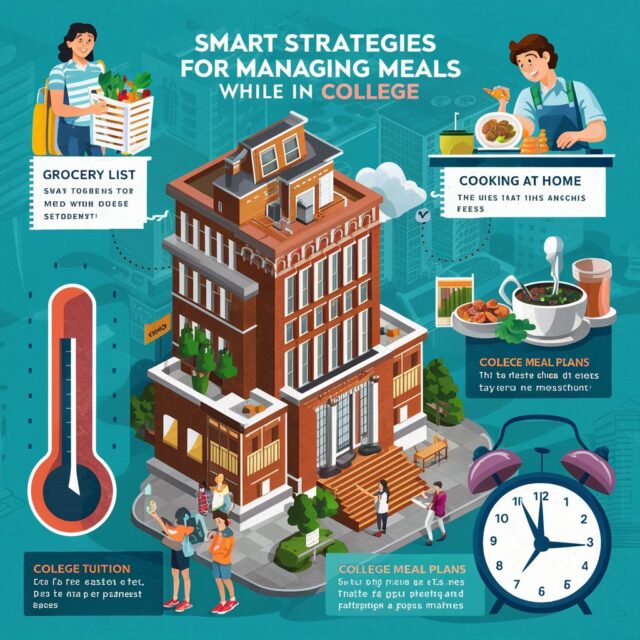
Searching for the way to spend the college year is inevitably managing your finances including budgeting for dining, which is one of the most important things. Maintaining a healthy social balance, finding time for personal well-being as you contend with the rigorous school work, and managing to put food on the table is a whole-maintenance thing but not an impossible one when you adopt the right strategies. Perfecting and including healthy eating on tight student budgets during college will not be difficult with a stroke of planning and imagination. Here are some savvy ways to eat at a low cost while in college:Here are some savvy ways to eat at a low cost while in college:
1. Meal Planning and Budgeting: Making a meal plan per week or month rooted in eating on a budget is the first step that amounts to this pursuit. Designate a certain amount of money for groceries per week, farewell in this amount and create the menu. For instance, you may look into basic items that are very economical such as rice, beans, pasta, and frozen vegetables that could be combined to produce multiple meals. Users can choose affordable options with apps like Mealime and Yummly for dietary constraints while shopping.
2. Cooking in Bulk: In addition to time the large volume of food preparation also cut the cost. Prepare meals in a large scale manner like soups, stews, or casseroles, and then divide them into single servings. Save the leftovers for your meals and cook them when you need some food, so that you will always have a yummy and low-priced choice.
3. Utilize Student Discounts: Use the student discounts put at your disposal by the grocery stores, restyurents, and cafes close to campus. Lots of those eaten places is like offering deals specifically for students, which means they can use many programs, particularly to save some funds when feeding.
4. Buy Generic Brands: The cheaper brands like generic or store brands can be impressive if the more famous ones are really too expensive. For most of people, a generic company might provide the same degree of quality at a more affordable price, thus helping you to buy more food with your budget than you would otherwise.
5. Shop Smart: Prioritize grocery shopping by planning trips which in turn generate higher savings. Utilize the in-store sales, promo offers, and coupons to find the frequencies of food costs. Among the tips, you may want to check on discount supermarkets and bulk food stores to keep down the cost for essential products.
6. Limit Eating Out: Having a meal at restaurant can be irresistible than cooking by yourself at home. Nevertheless, the latter is always cheaper. Eat-out only once in a while, for instance on special occasions or pick out affordable options such as food trucks or fast-casual restaurants. Baking lunches and cookies if you are attending classes or studying on campus can mute the need to inconvenience yourself by acquiring foods which are not wholesome at strange prices.
7. Embrace Meatless Meals: The most often meat is the source of the price tag. Adoption of menu items incorporating more vegetarian or vegan choices, helps with reducing cost of meals and provides all the necessary nutritional aspects. Doing your research gives you plenty of ideas for creative vegetarian and vegan dishes that can still offer the nutritional benefits of protein-rich ingredients that are more affordable options like beans, lentils, tofu, and eggs.
8. Grow Your Own Produce: In case you have some extra space, you can think about planting herbs or vegetable seedlings as your first orchard inside the house. The influence of fresh herbs and vegetables from one’s own garden is not only the taste and health value in your dishes but also more independence from store bought ingredients that saves money for the future.
9. Repurpose Leftovers: Make use of creative ideas for the unused food to lower the chance of wastage and having the ability to plan more with spent money. Turn last night’s meal into tomorrow’s omelet, salad, roll, or stir fry by adding the ingredients. Given that leftover rice can be made into a fried rice dish and some excess vegetables can be turned into soups or blended for smoothies the nutrients that serve one’s body may not be enough.
10. Community Resources: Look for site at grant programs, community gardens, or local marketplaces where you can get the vegetables at discounted rates or even for free to those in need. On top of that, a tons of college campuses may have programs or initiatives developed to attend to the dilemma of food shortage among students, offering access to healthful meals or food aid clubs.
11. DIY Snacks and Beverages: Do not waste your money on fancy packaged snacks and sugary drinks. Instead, choose cheaper healthier alternatives. As for the snacks make a healthy version using cheap, bulk-bought ingredients like popcorn, trail mix, or energy bars. By going for the water instead of a bottled drink, you get to save more money and also keep hydrated all day long.
12. Share Meals with Roommates or Friends: Don’t forget to synchronize meal times with your peers or roommates and even take turns with each other by taking the wheel on cooking and preparing healthy meals together. It helps to create the sense of affection, collaboration and variety thus the volunteers enjoy the regulated expenses and the advantages.












